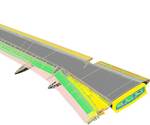Russian renaissance: Leading the OOA revolution?
Since the breakup of the Soviet Union in 1991, one of the most remarkable results has been a resurgence in aeromanufacturing within the Russian Federation.
Since the breakup of the Soviet Union in 1991, one of the most remarkable results has been a resurgence in aeromanufacturing within the Russian Federation. Russia has revamped its aircraft industry, consolidating private and state-owned entities — including renowned brands MiG, Tupolev, Ilyushin, Sukhoi and Beriev — under the umbrella of the United Aircraft Corp. (UAC, Moscow). The aircraft conglomerate’s stated strategic goal is to control 10 percent of the world civil aviation market, gain parity with world-level production efficiency by 2025, close the technology gap with other aeromanufacturers and boost high-tech R&D and innovation for the Russian economy. UAC has gathered eight aircraft manufacturing plants, three design bureaus, the Gromov Flight Research Institute and several new technology centers of excellence, including Moscow-based Scientific and Production Corp., Irkut and AeroComposit.
AeroComposit is currently in the renaissance spotlight. Its factory in Kazan, Tatarstan has already started to produce composite moveable wing components and control surfaces (including air brakes, spoilers, flaps and elevators) for the military Sukhoi Superjet SSJ-100 and is setting up for production of similar components for the new MS-21 single-aisle commercial transport aircraft. Meanwhile, its Ulyanovsk facility readies production for the MS-21 carbon fiber primary wing and wingbox structures — the first in a commercial airliner to be made using resin infusion (see "Resin-infused MS-21 wings and wingbox," under "Editor's Picks." at top right). AeroComposit is working in close cooperation with the Moscow-based aircraft OEM, Irkut.
Related Content
-
Sulapac introduces Sulapac Flow 1.7 to replace PLA, ABS and PP in FDM, FGF
Available as filament and granules for extrusion, new wood composite matches properties yet is compostable, eliminates microplastics and reduces carbon footprint.
-
Plant tour: Albany Engineered Composites, Rochester, N.H., U.S.
Efficient, high-quality, well-controlled composites manufacturing at volume is the mantra for this 3D weaving specialist.
-
TU Munich develops cuboidal conformable tanks using carbon fiber composites for increased hydrogen storage
Flat tank enabling standard platform for BEV and FCEV uses thermoplastic and thermoset composites, overwrapped skeleton design in pursuit of 25% more H2 storage.











.jpg;maxWidth=300;quality=90)

